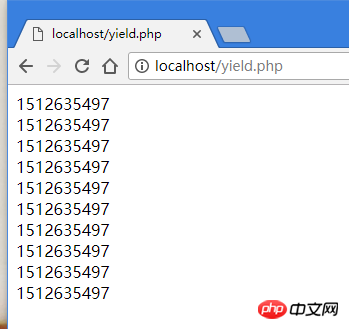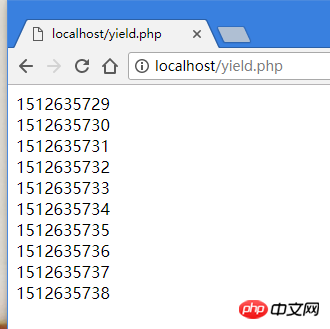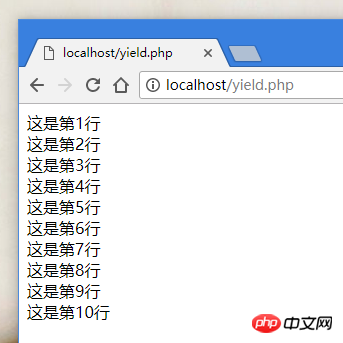 Backend Development
Backend Development
 PHP Tutorial
PHP Tutorial
 Performance optimization tool in PHP: Detailed explanation of PHP generator
Performance optimization tool in PHP: Detailed explanation of PHP generator
Performance optimization tool in PHP: Detailed explanation of PHP generator
This article introduces you to the performance optimization tool in PHP: a detailed explanation of the PHP generator. It has certain reference value. Friends in need can refer to it. I hope it will be helpful to you.
If you are working in Python or other languages, you should be familiar with generators. But many PHP developers may not know the generator function. It may be because the generator is a function introduced in PHP 5.5.0, or it may be that the function of the generator is not very obvious. However, the generator function is really useful.
Advantages
If I talk about the concept directly, I guess you will still be confused after listening to it, so let’s talk about the advantages first, maybe it can arouse your interest. So what are the advantages of generators, as follows:
Generators will have a very large impact on the performance of PHP applications
PHP code runtime Save a lot of memory
More suitable for calculating large amounts of data
So, how are these magical functions achieved? Let's give an example first.
Concept introduction
First of all, let’s put down the burden of the generator concept and look at a simple PHP function:
function createRange($number){
$data = [];
for($i=0;$i<p> This is a very common PHP function, we often use it when processing some arrays. The code here is also very simple: </p><ol class=" list-paddingleft-2">
<li><p>We create a function. </p></li>
<li><p>The function contains a <code>for</code> loop. We loop the current time into <code>$data</code></p></li>
<li><p><code>for</code>After the loop is executed, <code>$data</code> is returned. </p></li>
</ol><p> It’s not over yet, let’s continue. Let’s write another function and print out the return value of this function in a loop: </p><pre class="brush:php;toolbar:false">$result = createRange(10); // 这里调用上面我们创建的函数
foreach($result as $value){
sleep(1);//这里停顿1秒,我们后续有用
echo $value.'<br>';
}Let’s take a look at the running results in the browser:

It's perfect here, no problems whatsoever. (Of coursesleep(1)You can’t see the effect)
Think about a question
We noticed that when calling the functioncreateRange When is passed, the value passed to $number is 10, a very small number. Suppose, now pass a value 10000000 (10 million).
Then, in function createRange, the for loop needs to be executed 1000 times. And 1000 million values are placed in $data, and the $data array is placed in memory. Therefore, a lot of memory will be occupied when calling functions.
Here, the generator can show its talents.
Create generator
We modify the code directly, please pay attention:
function createRange($number){
for($i=0;$i<p>Look at this code that is very similar to just now, we delete it Array <code>$data</code>, and did not return any content, but used a keyword <code>yield</code><code></code># before </p>time()<p> ##Use the generator<strong></strong></p> Let’s run the second piece of code again: <p></p><pre class="brush:php;toolbar:false">$result = createRange(10); // 这里调用上面我们创建的函数
foreach($result as $value){
sleep(1);
echo $value.'<br>';
}
sleep(1). But why is there no gap the first time? That's because:
- When the generator is not used:
createRange
loops through a fixed array.The result of theforloop within thecreateRangefunction is quickly placed in$ dataand returns immediately. Therefore,foreach -
executes once.When using a generator: The value ofcreateRangeis not generated quickly at one time, but relies on theforeachloop.foreachloops once andfor
In-depth understanding of the generator
Code analysis
Let’s analyze the code just now.function createRange($number){
for($i=0;$i';
}-
the values that can be used in the first loop.First call thecreateRangefunction, passing in the parameter10, but theforvalue is executed once and then stops, And tellforeach -
executes the output.foreachStart the loop on$result, come in firstsleep(1), and then start usingA value given by for -
loop again.foreachprepares for the second loop. Before starting the second loop, it requests thefor -
.###forThe loop is then executed again, and the generated timestamp is told toforeach foreach拿到第二个值,并且输出。由于foreach中sleep(1),所以,for循环延迟了1秒生成当前时间
所以,整个代码执行中,始终只有一个记录值参与循环,内存中也只有一条信息。
无论开始传入的$number有多大,由于并不会立即生成所有结果集,所以内存始终是一条循环的值。
概念理解
到这里,你应该已经大概理解什么是生成器了。下面我们来说下生成器原理。
首先明确一个概念:生成器yield关键字不是返回值,他的专业术语叫产出值,只是生成一个值
那么代码中foreach循环的是什么?其实是PHP在使用生成器的时候,会返回一个Generator类的对象。foreach可以对该对象进行迭代,每一次迭代,PHP会通过Generator实例计算出下一次需要迭代的值。这样foreach就知道下一次需要迭代的值了。
而且,在运行中for循环执行后,会立即停止。等待foreach下次循环时候再次和for索要下次的值的时候,for循环才会再执行一次,然后立即再次停止。直到不满足条件不执行结束。
实际开发应用
很多PHP开发者不了解生成器,其实主要是不了解应用领域。那么,生成器在实际开发中有哪些应用?
读取超大文件
PHP开发很多时候都要读取大文件,比如csv文件、text文件,或者一些日志文件。这些文件如果很大,比如5个G。这时,直接一次性把所有的内容读取到内存中计算不太现实。
这里生成器就可以派上用场啦。简单看个例子:读取text文件

我们创建一个text文本文档,并在其中输入几行文字,示范读取。
<?php header("content-type:text/html;charset=utf-8");
function readTxt()
{
# code...
$handle = fopen("./test.txt", 'rb');
while (feof($handle)===false) {
# code...
yield fgets($handle);
}
fclose($handle);
}
foreach (readTxt() as $key => $value) {
# code...
echo $value.'<br>';
}
通过上图的输出结果我们可以看出代码完全正常。
但是,背后的代码执行规则却一点儿也不一样。使用生成器读取文件,第一次读取了第一行,第二次读取了第二行,以此类推,每次被加载到内存中的文字只有一行,大大的减小了内存的使用。
这样,即使读取上G的文本也不用担心,完全可以像读取很小文件一样编写代码。
相关文章推荐:
PHP7中生成器的新特性:生成器委托( yield-from )&返回值(return-value)
The above is the detailed content of Performance optimization tool in PHP: Detailed explanation of PHP generator. For more information, please follow other related articles on the PHP Chinese website!

Hot AI Tools

Undresser.AI Undress
AI-powered app for creating realistic nude photos

AI Clothes Remover
Online AI tool for removing clothes from photos.

Undress AI Tool
Undress images for free

Clothoff.io
AI clothes remover

AI Hentai Generator
Generate AI Hentai for free.

Hot Article

Hot Tools

Notepad++7.3.1
Easy-to-use and free code editor

SublimeText3 Chinese version
Chinese version, very easy to use

Zend Studio 13.0.1
Powerful PHP integrated development environment

Dreamweaver CS6
Visual web development tools

SublimeText3 Mac version
God-level code editing software (SublimeText3)

Hot Topics
 1378
1378
 52
52
 PHP 8.4 Installation and Upgrade guide for Ubuntu and Debian
Dec 24, 2024 pm 04:42 PM
PHP 8.4 Installation and Upgrade guide for Ubuntu and Debian
Dec 24, 2024 pm 04:42 PM
PHP 8.4 brings several new features, security improvements, and performance improvements with healthy amounts of feature deprecations and removals. This guide explains how to install PHP 8.4 or upgrade to PHP 8.4 on Ubuntu, Debian, or their derivati
 How To Set Up Visual Studio Code (VS Code) for PHP Development
Dec 20, 2024 am 11:31 AM
How To Set Up Visual Studio Code (VS Code) for PHP Development
Dec 20, 2024 am 11:31 AM
Visual Studio Code, also known as VS Code, is a free source code editor — or integrated development environment (IDE) — available for all major operating systems. With a large collection of extensions for many programming languages, VS Code can be c
 How do you parse and process HTML/XML in PHP?
Feb 07, 2025 am 11:57 AM
How do you parse and process HTML/XML in PHP?
Feb 07, 2025 am 11:57 AM
This tutorial demonstrates how to efficiently process XML documents using PHP. XML (eXtensible Markup Language) is a versatile text-based markup language designed for both human readability and machine parsing. It's commonly used for data storage an
 PHP Program to Count Vowels in a String
Feb 07, 2025 pm 12:12 PM
PHP Program to Count Vowels in a String
Feb 07, 2025 pm 12:12 PM
A string is a sequence of characters, including letters, numbers, and symbols. This tutorial will learn how to calculate the number of vowels in a given string in PHP using different methods. The vowels in English are a, e, i, o, u, and they can be uppercase or lowercase. What is a vowel? Vowels are alphabetic characters that represent a specific pronunciation. There are five vowels in English, including uppercase and lowercase: a, e, i, o, u Example 1 Input: String = "Tutorialspoint" Output: 6 explain The vowels in the string "Tutorialspoint" are u, o, i, a, o, i. There are 6 yuan in total
 Explain JSON Web Tokens (JWT) and their use case in PHP APIs.
Apr 05, 2025 am 12:04 AM
Explain JSON Web Tokens (JWT) and their use case in PHP APIs.
Apr 05, 2025 am 12:04 AM
JWT is an open standard based on JSON, used to securely transmit information between parties, mainly for identity authentication and information exchange. 1. JWT consists of three parts: Header, Payload and Signature. 2. The working principle of JWT includes three steps: generating JWT, verifying JWT and parsing Payload. 3. When using JWT for authentication in PHP, JWT can be generated and verified, and user role and permission information can be included in advanced usage. 4. Common errors include signature verification failure, token expiration, and payload oversized. Debugging skills include using debugging tools and logging. 5. Performance optimization and best practices include using appropriate signature algorithms, setting validity periods reasonably,
 7 PHP Functions I Regret I Didn't Know Before
Nov 13, 2024 am 09:42 AM
7 PHP Functions I Regret I Didn't Know Before
Nov 13, 2024 am 09:42 AM
If you are an experienced PHP developer, you might have the feeling that you’ve been there and done that already.You have developed a significant number of applications, debugged millions of lines of code, and tweaked a bunch of scripts to achieve op
 Explain late static binding in PHP (static::).
Apr 03, 2025 am 12:04 AM
Explain late static binding in PHP (static::).
Apr 03, 2025 am 12:04 AM
Static binding (static::) implements late static binding (LSB) in PHP, allowing calling classes to be referenced in static contexts rather than defining classes. 1) The parsing process is performed at runtime, 2) Look up the call class in the inheritance relationship, 3) It may bring performance overhead.
 What are PHP magic methods (__construct, __destruct, __call, __get, __set, etc.) and provide use cases?
Apr 03, 2025 am 12:03 AM
What are PHP magic methods (__construct, __destruct, __call, __get, __set, etc.) and provide use cases?
Apr 03, 2025 am 12:03 AM
What are the magic methods of PHP? PHP's magic methods include: 1.\_\_construct, used to initialize objects; 2.\_\_destruct, used to clean up resources; 3.\_\_call, handle non-existent method calls; 4.\_\_get, implement dynamic attribute access; 5.\_\_set, implement dynamic attribute settings. These methods are automatically called in certain situations, improving code flexibility and efficiency.



